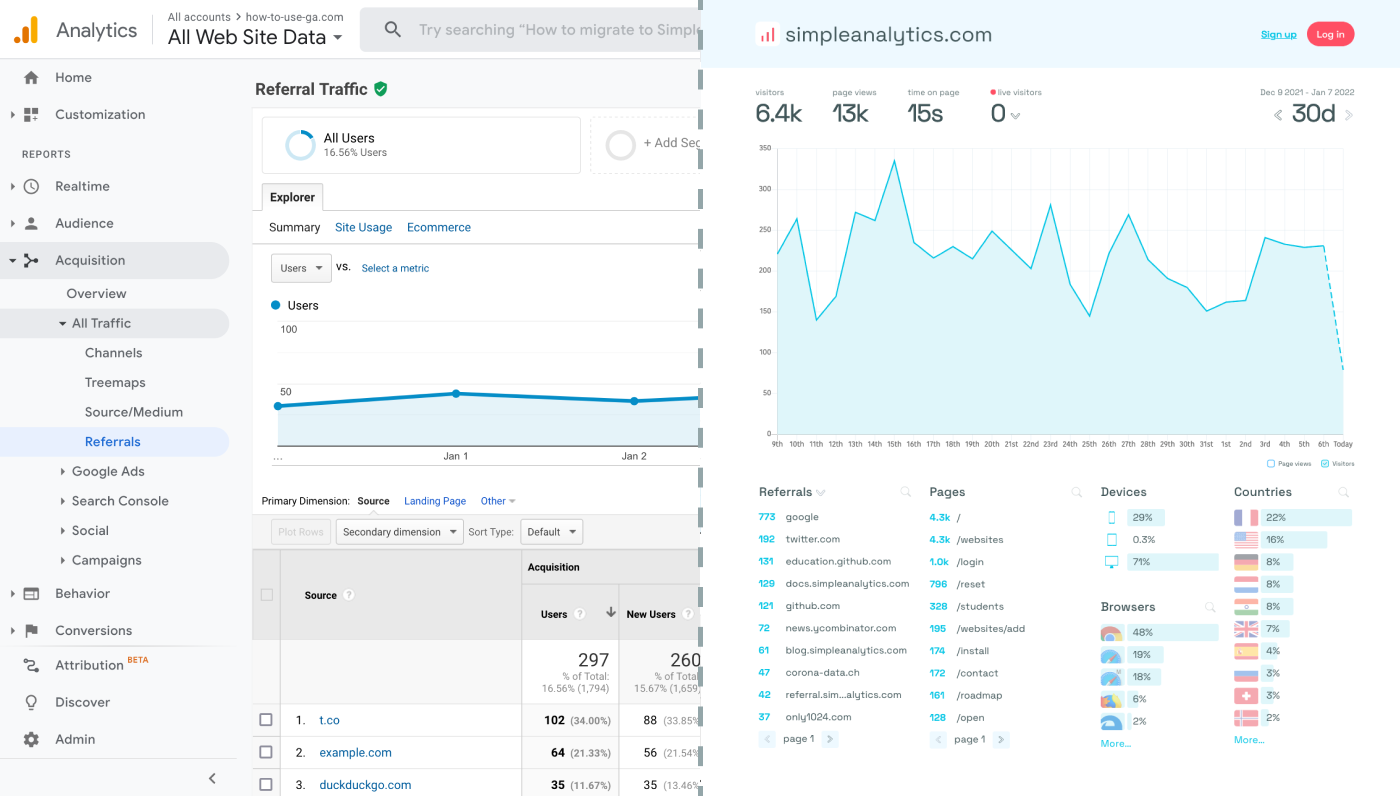After you have build a pretty website with Elementor, you will want to monitor and optimize its performance with robust web analytics- and Google Analytics can help. This blog will explain how to integrate Google Analytics, step by step.
Let's dive in!
- Set Up Google Analytics
- Add Google Analytics to Your Elementor Website
- SVerify the Integration
- Final Thoughts
Before we dig in I want to show you something. I promise it's worth it...
Google Analytics is great, but also complex and a bit clunky. If you just want a straightforward dashboard with the insights you need, GA is not a great place to start. Additionally, Google doesn't care about privacy and GA requires an annoying cookie banner.
That's why I built Simple Analytics, a privacy-friendly and simple analytics tool - no personal data, no cookies, just the insights you need in a straightforward dashboard.
Here is how it looks vs GA. Feel free to check our live analytics to get an idea for your project. (It is free btw)
All right, enough about us. Now let's get into answering your question!

Set Up Google Analytics
If you haven't already, the first step is to set up a Google Analytics account and create a property for your website. Here’s how:
- Create a Google Analytics Account: Visit the Google Analytics website and sign in with your Google account. If you don't have an account, you'll need to create one.
- Create a New Property: Follow the on-screen instructions to set up a new GA4 property, selecting "Web" as your platform.
- Obtain Your Tracking Code: Inspect your property to find your Tracking Code. You will need this code for the next steps.
- (Optional) Create Extra Properties: If you want to monitor multiple websites, create a new property for each website and extract its own tracking code. This prevents Google Analytics from conflating the data from different websites.
Add Google Analytics to Your Elementor Website
Integrating Google Analytics with your Elementor website can be done in a few ways, depending on your preference and the specifics of your site setup. Here are two common methods:
Using Elementor's Custom Code Feature (Pro Version Only)
If you're using Elementor Pro, you can easily add your GA tracking code directly to your site:
- Navigate to Theme Settings: From your WordPress dashboard, go to Elementor > Theme Builder.
- Access Site Settings: Click on "Site Settings" and then "Custom Code."
- Add Your GA Tracking Code: Click on "Add Custom Code," and paste your Google Analytics tracking code in the provided field. Be sure to place it in the
headsection as recommended by Google. - Publish Your Changes: Give your custom code a name for future reference, and click "Publish" to apply the changes.
Using a WordPress Plugin
For those using the free version of Elementor or who prefer not to use Elementor Pro's Custom Code feature, a WordPress plugin can be used:
- Choose a Plugin: There are several plugins available that facilitate Google Analytics integration. "Insert Headers and Footers" is a popular choice.
- Install and Activate the Plugin: From your WordPress dashboard, go to Plugins > Add New, search for your chosen plugin, install it, and then activate it.
- Insert Your GA Tracking Code: Navigate to the plugin's settings page and paste your GA tracking code into the designated field for scripts in the
headsection. - Save Your Changes: Ensure you save your changes to start tracking your site with Google Analytics.
SVerify the Integration
After adding the Google Analytics tracking code to your Elementor website, it's crucial to ensure it's working correctly:
- Check Realtime Reports in GA: Visit your website, then head to your Google Analytics account and view the Realtime report to see if your activity is being tracked.
- Use Google Tag Assistant: Google Tag Assistant is a Chrome extension that can help you verify if Google Analytics is correctly implemented on your site.
Final Thoughts
Adding Google Analytics to your website can give you great insights. However, ask yourself: is Google Analytics the right tool for you?
GA is an overpowered solution for straightforward analytics. If you're looking for a simple and intuitive dashboard with the insights you need, there are better alternatives. Yes, I’m talking about my own product (Simple Analytics), but there are others out there as well.
I hated using Google Analytics for my projects. It's clunky, there are hundreds of dashboards and it doesn't look appealing. Also Google doesn't care about privacy or ethics. That's why I decided to build my own and more intuitive web analytics tool.
If this resonates with you, feel free to give Simple Analytics a spin. You just need to add the script to your website and off you go. This takes about one minute- and there is a free version as well!
Enjoy!
